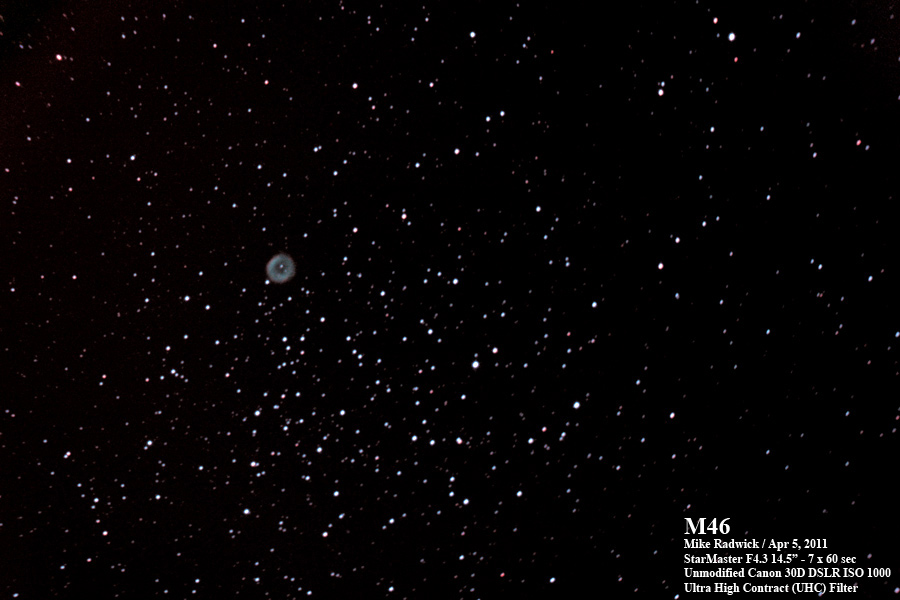


Hello everyone,
Despite several recent observing runs, the long winter has left me desperate to gather as many photons as possible. Last Tuesday (April 5, 2011) presented an brief opportunity to setup and test the tracking of my 14.5” StarMaster. As time was a factor (it was cloudy all day and the weather service was predicting rain after midnight), I setup in my very urban driveway. The light pollution here is almost as bad as from downtown Ann Arbor (a good night allows only 20-30 stars to be seen), plus spotlights from the neighbors houses, plus a “turn-night-into-day” street lamp at the end of my driveway.
Under these conditions, I generally avoid deep-sky targets at home, and rarely try astro imaging. But I’ve recently been encouraged by some web sites showing photos taken from downtown conditions using filters. I do not have any photo-specific filters, and the last (and first) time I tried the result was disappointing to say the least. But I gave it another try anyway using an Astronomik UHC filter, and produced the attached image of M46.
M46 is a typical run-of-the-mill open cluster, with 150 or so bright stars and up to 500 stars total. The cluster is about 30 light-years across and 5400 light-years away. The cluster is relatively young, about 300 million years old. Note that there are many bright blue stars in the group (the color reflects something of the star’s temperature, blue indicates a very hot star).
My favorite feature however is the planetary nebula NGC2438 which appears like a donut towards the left and slightly above center. The PN is not part of the cluster (it is thought to be in the foreground of M46, but the exact distance is unknown). At Peach Mountain I can only see a faint soap-bubble blob with my eye. From home I could not see the nebula at all. However, John Causland and I were recently observing this with his 24” scope, and I was able to discern a ring shape and some faint stars inside the ring. I’m not really sure if John believed me when I said I could see such detail, but this photo confirms it.
I was using a unmodified Canon 30D DSLR camera (ISO 1000) at the prime-focus of the scope. PHD-Guiding software was used with a Orion Starshoot Guider in order to control the scope. The image is a combination of 7 photos, each exposed for 60 seconds. I actually took 25 frames, but most were ruined by a constant flow of traffic in front of the house (surprise!—the problem was usually NOT car headlights, rather vibration from the cars shook the scope and turned the stars into little wiggles). But at least I saw very few tracking issues. The images were stacked using Deep-Sky-Stacker and then tweaked using Photoshop CS4. I hope you enjoy the result. As always, comments (especially suggestions on how to improve the image) are welcome.
Clear Skies,
Mike Radwick